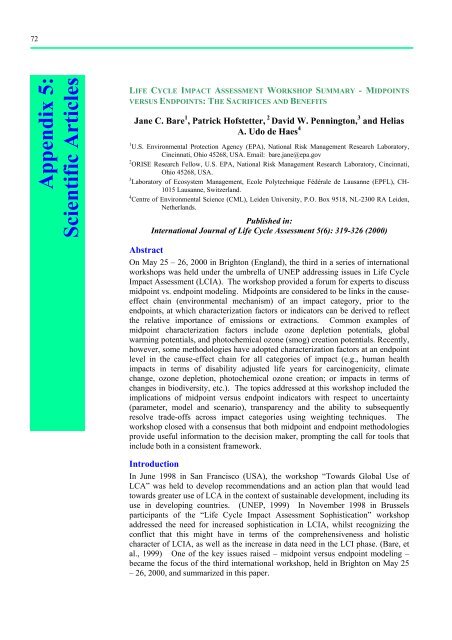Evaluation of Environmental Impacts in Life Cycle Assessment - estis
Evaluation of Environmental Impacts in Life Cycle Assessment - estis
Evaluation of Environmental Impacts in Life Cycle Assessment - estis
You also want an ePaper? Increase the reach of your titles
YUMPU automatically turns print PDFs into web optimized ePapers that Google loves.
72<br />
Appendix 5:<br />
Scientific Articles<br />
LIFE CYCLE IMPACT ASSESSMENT WORKSHOP SUMMARY - MIDPOINTS<br />
VERSUS ENDPOINTS: THE SACRIFICES AND BENEFITS<br />
Jane C. Bare 1 , Patrick H<strong>of</strong>stetter, 2 David W. Penn<strong>in</strong>gton, 3 and Helias<br />
A. Udo de Haes 4<br />
1 U.S. <strong>Environmental</strong> Protection Agency (EPA), National Risk Management Research Laboratory,<br />
C<strong>in</strong>c<strong>in</strong>nati, Ohio 45268, USA. Email: bare.jane@epa.gov<br />
2 ORISE Research Fellow, U.S. EPA, National Risk Management Research Laboratory, C<strong>in</strong>c<strong>in</strong>nati,<br />
Ohio 45268, USA.<br />
3 Laboratory <strong>of</strong> Ecosystem Management, Ecole Polytechnique Fédérale de Lausanne (EPFL), CH-<br />
1015 Lausanne, Switzerland.<br />
4 Centre <strong>of</strong> <strong>Environmental</strong> Science (CML), Leiden University, P.O. Box 9518, NL-2300 RA Leiden,<br />
Netherlands.<br />
Published <strong>in</strong>:<br />
International Journal <strong>of</strong> <strong>Life</strong> <strong>Cycle</strong> <strong>Assessment</strong> 5(6): 319-326 (2000)<br />
Abstract<br />
On May 25 – 26, 2000 <strong>in</strong> Brighton (England), the third <strong>in</strong> a series <strong>of</strong> <strong>in</strong>ternational<br />
workshops was held under the umbrella <strong>of</strong> UNEP address<strong>in</strong>g issues <strong>in</strong> <strong>Life</strong> <strong>Cycle</strong><br />
Impact <strong>Assessment</strong> (LCIA). The workshop provided a forum for experts to discuss<br />
midpo<strong>in</strong>t vs. endpo<strong>in</strong>t model<strong>in</strong>g. Midpo<strong>in</strong>ts are considered to be l<strong>in</strong>ks <strong>in</strong> the causeeffect<br />
cha<strong>in</strong> (environmental mechanism) <strong>of</strong> an impact category, prior to the<br />
endpo<strong>in</strong>ts, at which characterization factors or <strong>in</strong>dicators can be derived to reflect<br />
the relative importance <strong>of</strong> emissions or extractions. Common examples <strong>of</strong><br />
midpo<strong>in</strong>t characterization factors <strong>in</strong>clude ozone depletion potentials, global<br />
warm<strong>in</strong>g potentials, and photochemical ozone (smog) creation potentials. Recently,<br />
however, some methodologies have adopted characterization factors at an endpo<strong>in</strong>t<br />
level <strong>in</strong> the cause-effect cha<strong>in</strong> for all categories <strong>of</strong> impact (e.g., human health<br />
impacts <strong>in</strong> terms <strong>of</strong> disability adjusted life years for carc<strong>in</strong>ogenicity, climate<br />
change, ozone depletion, photochemical ozone creation; or impacts <strong>in</strong> terms <strong>of</strong><br />
changes <strong>in</strong> biodiversity, etc.). The topics addressed at this workshop <strong>in</strong>cluded the<br />
implications <strong>of</strong> midpo<strong>in</strong>t versus endpo<strong>in</strong>t <strong>in</strong>dicators with respect to uncerta<strong>in</strong>ty<br />
(parameter, model and scenario), transparency and the ability to subsequently<br />
resolve trade-<strong>of</strong>fs across impact categories us<strong>in</strong>g weight<strong>in</strong>g techniques. The<br />
workshop closed with a consensus that both midpo<strong>in</strong>t and endpo<strong>in</strong>t methodologies<br />
provide useful <strong>in</strong>formation to the decision maker, prompt<strong>in</strong>g the call for tools that<br />
<strong>in</strong>clude both <strong>in</strong> a consistent framework.<br />
Introduction<br />
In June 1998 <strong>in</strong> San Francisco (USA), the workshop “Towards Global Use <strong>of</strong><br />
LCA” was held to develop recommendations and an action plan that would lead<br />
towards greater use <strong>of</strong> LCA <strong>in</strong> the context <strong>of</strong> susta<strong>in</strong>able development, <strong>in</strong>clud<strong>in</strong>g its<br />
use <strong>in</strong> develop<strong>in</strong>g countries. (UNEP, 1999) In November 1998 <strong>in</strong> Brussels<br />
participants <strong>of</strong> the “<strong>Life</strong> <strong>Cycle</strong> Impact <strong>Assessment</strong> Sophistication” workshop<br />
addressed the need for <strong>in</strong>creased sophistication <strong>in</strong> LCIA, whilst recogniz<strong>in</strong>g the<br />
conflict that this might have <strong>in</strong> terms <strong>of</strong> the comprehensiveness and holistic<br />
character <strong>of</strong> LCIA, as well as the <strong>in</strong>crease <strong>in</strong> data need <strong>in</strong> the LCI phase. (Bare, et<br />
al., 1999) One <strong>of</strong> the key issues raised – midpo<strong>in</strong>t versus endpo<strong>in</strong>t model<strong>in</strong>g –<br />
became the focus <strong>of</strong> the third <strong>in</strong>ternational workshop, held <strong>in</strong> Brighton on May 25<br />
– 26, 2000, and summarized <strong>in</strong> this paper.
















